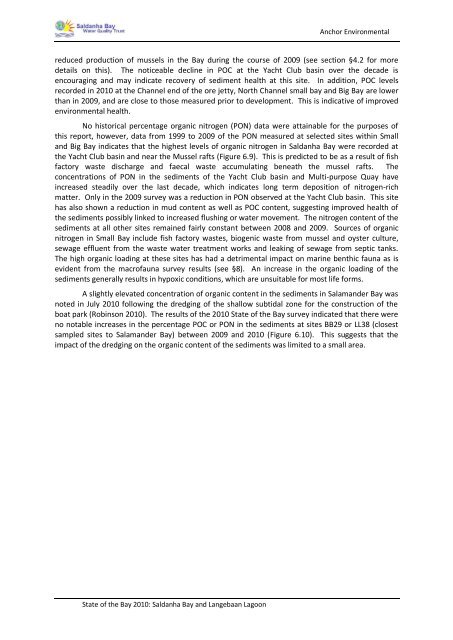State of the Bay Report 2010-Final - Anchor Environmental
State of the Bay Report 2010-Final - Anchor Environmental
State of the Bay Report 2010-Final - Anchor Environmental
You also want an ePaper? Increase the reach of your titles
YUMPU automatically turns print PDFs into web optimized ePapers that Google loves.
<strong>State</strong> <strong>of</strong> <strong>the</strong> <strong>Bay</strong> <strong>2010</strong>: Saldanha <strong>Bay</strong> and Langebaan Lagoon<br />
<strong>Anchor</strong> <strong>Environmental</strong><br />
reduced production <strong>of</strong> mussels in <strong>the</strong> <strong>Bay</strong> during <strong>the</strong> course <strong>of</strong> 2009 (see section §4.2 for more<br />
details on this). The noticeable decline in POC at <strong>the</strong> Yacht Club basin over <strong>the</strong> decade is<br />
encouraging and may indicate recovery <strong>of</strong> sediment health at this site. In addition, POC levels<br />
recorded in <strong>2010</strong> at <strong>the</strong> Channel end <strong>of</strong> <strong>the</strong> ore jetty, North Channel small bay and Big <strong>Bay</strong> are lower<br />
than in 2009, and are close to those measured prior to development. This is indicative <strong>of</strong> improved<br />
environmental health.<br />
No historical percentage organic nitrogen (PON) data were attainable for <strong>the</strong> purposes <strong>of</strong><br />
this report, however, data from 1999 to 2009 <strong>of</strong> <strong>the</strong> PON measured at selected sites within Small<br />
and Big <strong>Bay</strong> indicates that <strong>the</strong> highest levels <strong>of</strong> organic nitrogen in Saldanha <strong>Bay</strong> were recorded at<br />
<strong>the</strong> Yacht Club basin and near <strong>the</strong> Mussel rafts (Figure 6.9). This is predicted to be as a result <strong>of</strong> fish<br />
factory waste discharge and faecal waste accumulating beneath <strong>the</strong> mussel rafts. The<br />
concentrations <strong>of</strong> PON in <strong>the</strong> sediments <strong>of</strong> <strong>the</strong> Yacht Club basin and Multi-purpose Quay have<br />
increased steadily over <strong>the</strong> last decade, which indicates long term deposition <strong>of</strong> nitrogen-rich<br />
matter. Only in <strong>the</strong> 2009 survey was a reduction in PON observed at <strong>the</strong> Yacht Club basin. This site<br />
has also shown a reduction in mud content as well as POC content, suggesting improved health <strong>of</strong><br />
<strong>the</strong> sediments possibly linked to increased flushing or water movement. The nitrogen content <strong>of</strong> <strong>the</strong><br />
sediments at all o<strong>the</strong>r sites remained fairly constant between 2008 and 2009. Sources <strong>of</strong> organic<br />
nitrogen in Small <strong>Bay</strong> include fish factory wastes, biogenic waste from mussel and oyster culture,<br />
sewage effluent from <strong>the</strong> waste water treatment works and leaking <strong>of</strong> sewage from septic tanks.<br />
The high organic loading at <strong>the</strong>se sites has had a detrimental impact on marine benthic fauna as is<br />
evident from <strong>the</strong> macr<strong>of</strong>auna survey results (see §8). An increase in <strong>the</strong> organic loading <strong>of</strong> <strong>the</strong><br />
sediments generally results in hypoxic conditions, which are unsuitable for most life forms.<br />
A slightly elevated concentration <strong>of</strong> organic content in <strong>the</strong> sediments in Salamander <strong>Bay</strong> was<br />
noted in July <strong>2010</strong> following <strong>the</strong> dredging <strong>of</strong> <strong>the</strong> shallow subtidal zone for <strong>the</strong> construction <strong>of</strong> <strong>the</strong><br />
boat park (Robinson <strong>2010</strong>). The results <strong>of</strong> <strong>the</strong> <strong>2010</strong> <strong>State</strong> <strong>of</strong> <strong>the</strong> <strong>Bay</strong> survey indicated that <strong>the</strong>re were<br />
no notable increases in <strong>the</strong> percentage POC or PON in <strong>the</strong> sediments at sites BB29 or LL38 (closest<br />
sampled sites to Salamander <strong>Bay</strong>) between 2009 and <strong>2010</strong> (Figure 6.10). This suggests that <strong>the</strong><br />
impact <strong>of</strong> <strong>the</strong> dredging on <strong>the</strong> organic content <strong>of</strong> <strong>the</strong> sediments was limited to a small area.

















